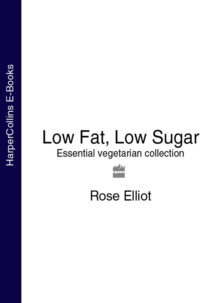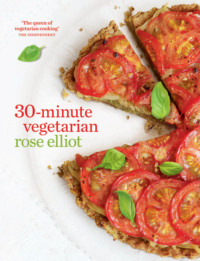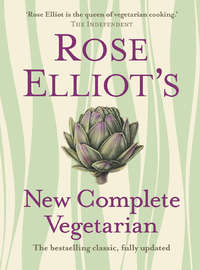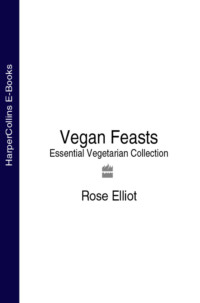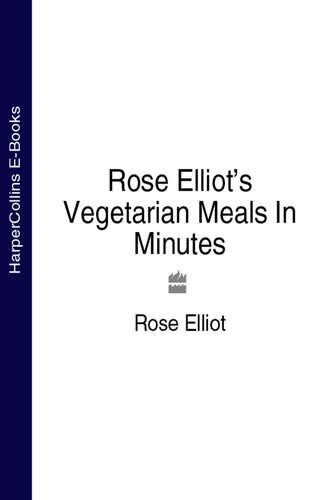
Полная версия
Rose Elliot’s Vegetarian Meals In Minutes


COPYRIGHT
Collins
an imprint of HarperCollinsPublishers
1 London Bridge Street
London SE1 9GF
www.harpercollins.co.uk
First published in paperback 1998; previously published
in 1994 as Rose Elliot’s Vegetarian Fast Food.
Text © Rose Elliot 1994, 1998
Photographs © David Armstrong 1994
All rights reserved
Editor: Jane Middleton
Text designer: Joan Curtis
Photographer: Dave Armstrong
Home Economist: Lyn Rutherford
Stylist: Róisín Nield
Illustrator: Lucinda Rogers
Indexer: Susan Bosanko
A catalogue record for this book is available from the British Library.
Publishing Director: Denise Bates
Senior Managing Editor: Angela Newton
Editorial Assistant: Lisa John
Rose Elliot asserts the moral right to be identified as the author of this work
All rights reserved under International and Pan-American Copyright Conventions. By payment of the required fees, you have been granted the nonexclusive, nontransferable right to access and read the text of this e-book on-screen. No part of this text may be reproduced, transmitted, downloaded, decompiled, reverse-engineered, or stored in or introduced into any information storage and retrieval system, in any form or by any means, whether electronic or mechanical, now known or hereafter invented, without the express written permission of HarperCollins e-books.
Source ISBN 9780007193196
Ebook Edition © JANUARY 2015 ISBN: 9780007405565
Version: 2015-01-26
HarperCollinsPublishers has made every reasonable effort to ensure that any picture content and written content in this ebook has been included or removed in accordance with the contractual and technological constraints in operation at the time of publication.
With book sales of three million, Rose Elliot is Britain’s bestselling vegetarian cookery anchor. She has earned the praise of vegetarians and non-vegetarians alike for the originality and imaginativeness of her recipes.
Her first book, Simply Delicious, was written in response to the many requests for recipes she received from visitors to the retreat centre run by her parents, where she then cooked. The book was widely praised and, since then, Rose has written many bestsellers. Vegetarian Christmas, Vegan Feasts, The Bean Book and Low Fat, Low Sugar are published in paperback by Thorsons.
Rose Elliot frequently contributes to national magazines, gives cookery demonstrations and broadcasts on radio and television. She lives with her husband, Robert, in Hampshire. Rose has always had a great interest in astrology and has practised this alongside her career as a cookery writer. With Robert she runs a computer-based astrological service which provides high quality personality profiles, forecasts and compatability charts. More details can be obtained from: Rose Elliot Horoscopes, PO Box 16, Eastleigh, Hampshire SO50 5YP.

CONTENTS
COVER
TITLE PAGE
COPYRIGHT
STORECUPBOARD
BREAD

Introduction
Crostini & Bruschetta
Quick Pizzas
Snacks on Toast
Open Sandwiches & Pan Bagnat
Pitta Pockets
Tortillas & Poppadums
Croissants, Rolls & Sweet Ideas
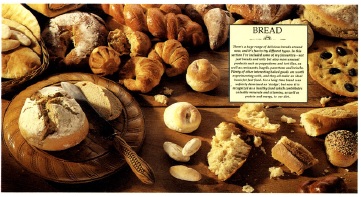
EGGS, CHEESE & DAIRY FOODS

Introduction
Omelettes
Crèpes
Cheese Salads
Fried, Melted & Grilled Cheese
Puddings with Cheese, Cream & Yogurt
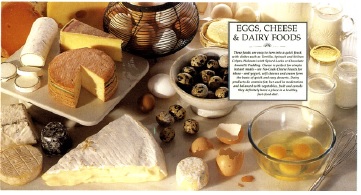
PASTA

Introduction
Tomato Sauces
Light Pasta Dishes
Cheese & Cream Sauces

PULSES, GRAINS & NUTS

Introduction
Beans & Lentils
Rice
Bulgur, Couscous & Polenta
Nuts

VEGETABLES

Introduction
Soups & Top-of-the-Stove Dishes
Gratins & Grills
Potato Wedges
Spiced Vegetable Dishes
Fritters & Fried Vegetables
Stir-Fries
Main-Course Salads
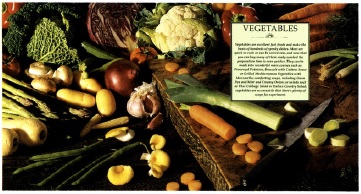
FRUIT

Introduction
Fruit Salads & Savoury Fruit Dishes
Cold Puddings
Hot Puddings
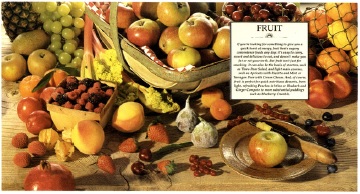
ABOUT THE PUBLISHER
THE STORECUPBOARD

Most of the recipes in this book are based on a combination of fresh ingredients and ingredients that keep well in a storecuboard, such as pasta, rice and spices. A well-stocked storecupboard saves time; after the initial stocking-up it’s just a matter of replenishing it when required. You don’t have to shop every day to make quick vegetarian meals: fresh vegetables and dairy produce keep very well in the fridge; herbs in jugs of water or growing in pots in a light place; and bread, if you want some in reserve, in the freezer. These are the ingredients I find most useful to have in stock, and many of the recipes in this book rely on them.
DRY GOODS
I like to keep in several packets of pasta in different shapes and a supply of split red lentils, which cook more quickly than other pulses and don’t need soaking. Various types of rice are also indispensable: brown basmati is the only wholegrain rice that cooks in under 30 minutes, and white basmati takes even less time. Bulgur wheat, couscous, instant polenta, chick pea (gram) flour, cornflour and dried breadcrumbs are worth having for occasional use, and flour (both white and wholemeal) and baking powder are storecupboard basics. Wheatmeal and amaretti biscuits keep fairly well and make a good base for various puddings. Dried fruits are useful for both sweet and savoury dishes, as are nuts, seeds, desiccated coconut, coconut milk powder and creamed coconut. Try to keep several types of nuts and seeds in stock, such as walnuts, hazelnuts, cashews, pine nuts, sunflower seeds and sesame seeds. If possible, store nuts in the fridge or freezer to prevent them from going rancid. In any case, buy them in small quantities.
CANNED AND FROZEN FOOD
Certain canned ingredients are invaluable for making fast food – green lentils, chick peas, different types of beans, canned sweetcorn (without added sugar), artichoke hearts and tomatoes in juice. Canned whole tomatoes are usually of better quality than the chopped ones and it’s easy to break them up quickly with a spoon once they’re in the saucepan. Canned chestnuts and unsweetened chestnut purée come in handy, whether it’s to make a hearty winter stew or whip up a luxurious quick pudding. I like the vacuum-packed canned whole chestnuts that are now available. It’s also possible to buy frozen peeled chestnuts. Other frozen foods I like to keep in stock are sweetcorn, petit pois and leaf spinach. Sticks of frozen double or whipping cream are useful, too, for when you need just a small quantity.
FLAVOURING INGREDIENTS
Flavouring ingredients are doubly important for fast food, because you need to add interest and intensity of taste without a lengthy cooking period. It’s worth spending a little time and money, therefore, building up a collection of spices and herbs, sweet and savoury flavourings, and good oils and vinegars. At the most basic level, you need good salt – I like flaky Maldon sea salt which you can crush in your fingers – and a grinder for black peppercorns. Other basics are light olive oil for shallow-frying and a good-quality virgin olive oil for salad dressings. For stir-frying and occasional deep-frying I use groundnut oil because it is the most stable at high temperatures; also dark sesame oil for adding flavour to stir-fries and oriental dishes. Vinegars to keep in stock are red wine vinegar, balsamic vinegar and light, sweet brown rice vinegar, all of which have their own individual character. Tabasco sauce and soy sauce pep up food instantly – choose soy sauce that is naturally matured and contains only soya beans and salt. Then there’s mustard, preferably smooth Dijon as well as wholegrain Meaux mustard; good bought mayonnaise such as Hellman’s; and jars of capers, black olive pâté (the type made only with black olives and olive oil is best), sun-dried tomatoes, pesto sauce and black olives (my favourites are the Greek Kalamata or the little Niçois olives – all of these are best kept in the fridge.
For sweet flavourings, I use both clear and thick honey and stem ginger preserved in syrup; I also find ginger preserve, a kind of ginger jam, useful. Rose and orange flower waters are versatile flavourings, and perhaps even better are liqueurs such as Cointreau or Amaretto, and eau de vie. My favourite is eau de vie de poire William – horribly expensive but divine in a delicate pear dessert.
The spices I find most useful are cinnamon (in sticks and ground) cloves, cardamom, cayenne, chilli powder, whole and ground coriander, whole and ground cumin, ground turmeric, paprika, dried red chillies, and whole nutmegs for grating when needed. Mustard seeds and curry powder are good for occasional use. As far as herbs are concerned, thyme, sage, rosemary and oregano seem to survive the drying process well, and bay is actually better and more concentrated in flavour when dried. Being able to buy fresh herbs easily has made a huge difference to the fast cook’s repertoire, and I find they keep well in their little pots or in jars of water – fresh mint, basil, parsley, dill, coriander, chives, chervil, tarragon and parsley (particularly flat-leaf) will liven up your cooking immensely. Lemon grass, green chillies and fresh ginger root are also widely available now, and are best kept in the fridge.
FRESH PRODUCE
Basic dairy produce such as eggs – always free range – milk, cream and yogurt should, of course, be kept in the fridge, along with soft and hard cheeses, including a block of fresh Parmesan for grating as required. Fresh vegetables such as tomatoes, salad leaves, carrots and cabbage keep well in the fridge, too. Other basic standbys are onions, garlic, potatoes, oranges and lemons, which I keep in a cool, dark cupboard, and bread, which goes into a bread crock, with a back-up supply in the freezer.
EQUIPMENT
The right equipment makes all the difference to the ease with which you can cook fast food. A little time spent removing clutter, re-thinking your needs, and streamlining and reorganizing kitchen surfaces and cupboards can save hours of your time over the weeks and months.
It’s essential to invest in efficient kitchen tools. You don’t need a lot of fancy equipment: the most important thing is a really good, sharp knife, and for that you do get what you pay for. Personally I like a classic Sabatier knife with a medium-length (11cm/41/2 inch) blade. A good, solid chopping board is essential, too, the bigger the better. The other small tools I find indispensable are a swivel potato peeler with a long handle that is really comfortable to hold, and a citrus zester, which is a curiously useful gadget. A garlic press is more bother than it is worth, in my opinion – you can do the job much more quickly and effectively with a knife and a board.
A food processor isn’t essential, and many of the recipes in this book can be made without one, but it does open up many more possibilities – lovely creamy soups, quick pâtés and dips, for instance. As with so many things, if you’re buying one it pays to get a larger version than you think you’ll need; go for something simple in design which doesn’t try to do too many jobs. Try to make a space for it on your work surface so that it’s always there at the ready. An electric hand whisk is also a surprisingly useful and labour-saving piece of equipment, and fairly inexpensive to buy. For years I put off buying one, and when eventually I did I couldn’t believe how useful it was and wondered why I hadn’t bought one earlier.
A microwave oven isn’t essential by any means, and apart from a microwave version of risotto none of the recipes in this book depend on one. I find a pressure cooker more useful than a microwave because I love making soups and it cooks them very quickly. Some people are wary of pressure cookers because of all their hissing, but once you know what you are doing it can be invaluable.
Finally, a large saucepan with a steamer on top is helpful if you’re cooking with limited hob space, because you can have one item cooking in the pan and a vegetable or something else steaming in the top. I have a stainless-steel steamer that I use a lot in this way.

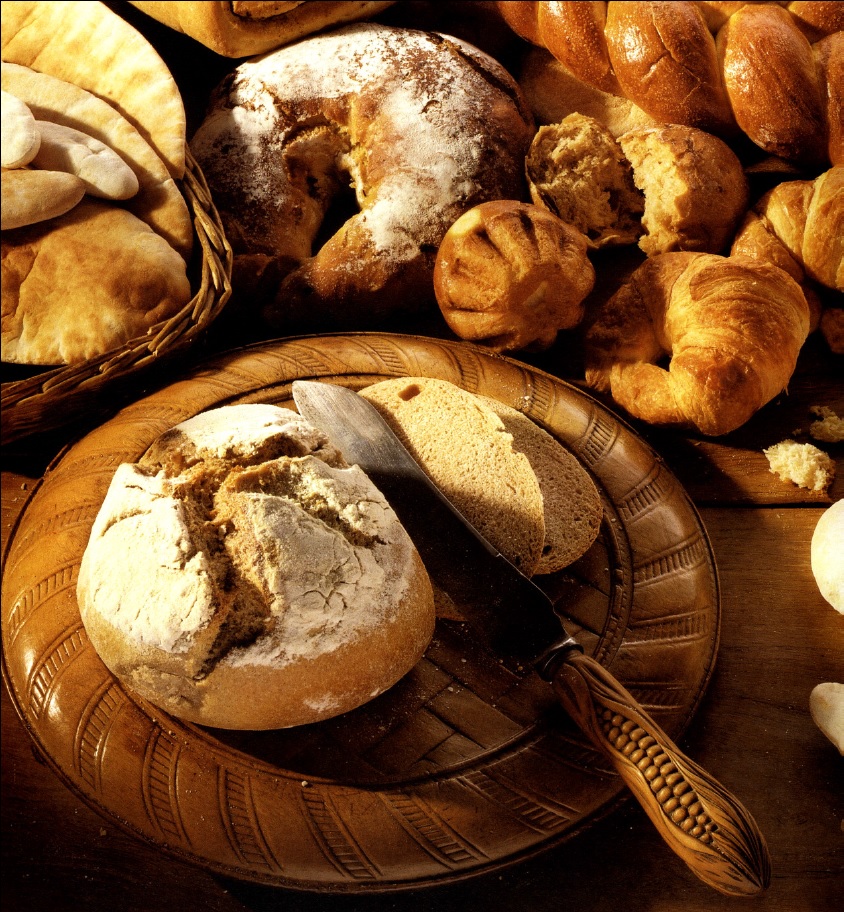
BREAD

There’s a huge range of delicious breads around now, and it’s fun to try different types. In this section I’ve included some of my favourites – not just breads and rolls but also more unusual products such as poppadums and tortillas, as well as croissants, bagels, panettone and brioche. Plenty of other interesting baked goods are worth experimenting with, and they all make an ideal basis for fast food. For a long time bread was unfairly dismissed as 'stodge', but now it is recognized as a healthy food which contributes valuable minerals and vitamins, as well as protein and energy, to our diet.
CROSTINI & BRUSCHETTA

These Italian toasts are really very similar: crostini are delicate rounds of light, crisp bread whereas bruschetta is made from coarse country bread and rubbed with garlic to flavour it. They can be served plain to accompany soup, salads or dips, or topped with all kinds of delicious things to make canapés, quick snacks or light meals. If you are making a meal of them they are good served with some salad. You can use either a small or large baguette for crostini, depending on how big you want the rounds to be, and since one baguette yields about 50 slices, you only need a small piece to make a snack or meal for two people.
BASIC RECIPE
4 slices from a large baguette or 8 slices from a small one, cut 6mm / 1/4 inch thick, for crostini
2 slices from a country-style loaf for bruschetta
olive oil
1 garlic clove, peeled and cut in half, for bruschetta


SERVES 2
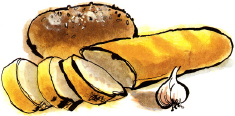
TOPPINGS
All these toppings make enough for 8 small or 4 large crostini, or 2 bruschetta. Serve the crostini or bruschetta as soon as possible after adding the toppings.
— 1 —
CHERRY TOMATOES, FETA AND THYME
6–8 cherry tomatoes crostini or bruschetta (see above)
50g / 2oz feta cheese
sprigs of thyme
freshly ground black pepper


— 2 —
BLACK OLIVE PATE, RED PEPPER AND CAPERS
1 red pepper
black olive pâté
crostini or bruschetta (see above)
2–3 tsp capers
a few leaves of flat-leaf parsley



— 3 —
AUBERGINE AND MINT
1 medium aubergine
olive oil
4 sprigs of mint
balsamic vinegar
salt and freshly ground black pepper
crostini or bruschetta (see here)



— 4 —
LENTILS WITH CRANBERRIES
This Christmassy variation can be made very quickly with canned lentils.
1 small onion, peeled and chopped
1 tbls olive oil
1 × 425g / 15oz can of lentils
crostini or bruschetta (see here)
2 tbls cranberry sauce, preferably containing whole cranberries
sprigs of flat-leaf parsley




— 5 —
BLUE CHEESE WITH GRAPES, PINE NUTS AND CHICORY
crostini or bruschetta (see here)
a few leaves of chicory
125g 14oz blue cheese
6 black grapes
a few pine nuts



— 6 —
GOAT’S CHEESE, ROCKET AND SUN-DRIED TOMATO
125g / 4oz soft white goat’s cheese
crostini or bruschetta (see here)
8 sun-dried tomatoes in oil, drained
several rocket leaves
freshly ground black pepper






